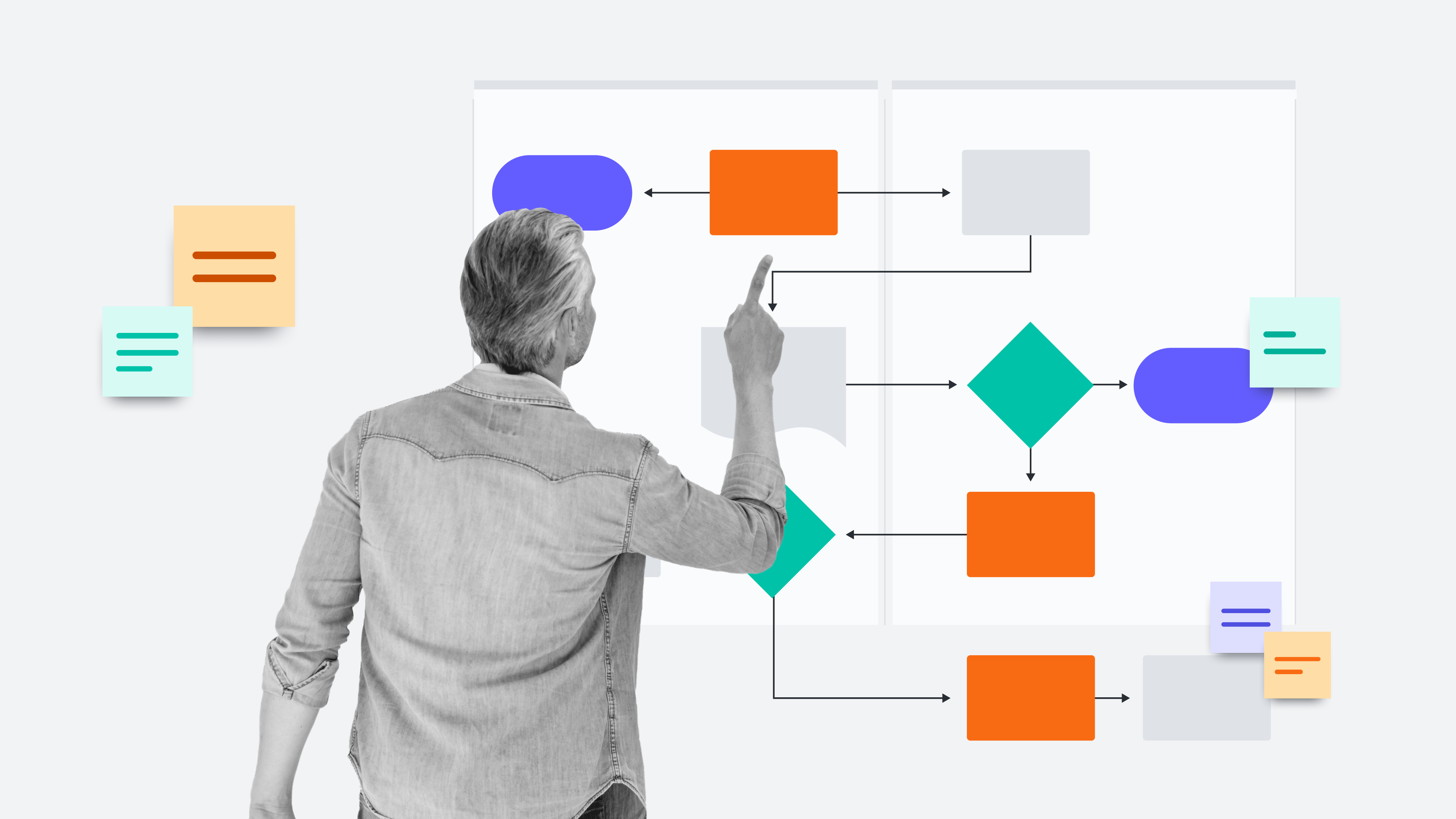With the right data model, you can visualize how your database works—from the data elements to the relationships among them and how data is used in business processes. There are different types of data models and they have different uses and value in their own contexts.
What is data modeling?
Data modeling is the process of illustrating information systems, in whole or in part, through visual representations like diagrams and flowcharts. Using text and symbols, data modeling visualizes and communicates relationships between data elements—effectively functioning as a blueprint for an organization’s information systems.
Data models provide a unified view of an organization’s data and systems. This helps data management teams document and analyze data requirements, uncover errors, and use the data effectively for their business.
Conceptual vs. logical vs. physical data models
Data modeling is a core part of enterprise data management. Database development is one area where data models are useful, but data modeling actually offers value in a broader range of use cases. By visualizing data elements and their relationships, teams can use data models to shape business processes and technical designs. For business information systems, it is absolutely critical to understand and communicate about data effectively—placing data modeling at the center of how organizations leverage data.
There are three general types of data models that you can use depending on your needs and goals: Conceptual data models, logical data models, and physical data models. These three data models have a lot in common, but there are also important distinctions between them. Choosing the right data model for each use case helps you maximize the value your team gains from data modeling.
Conceptual data model (CDM)
CDMs are very high-level. This high-level perspective makes conceptual data modeling ideal for presenting information to stakeholders and those in non-technical roles in your organization. With further development, you can modify the data model into other models with greater complexity and detail, making conceptual models a great starting point as you move into other diagrams.
During the early stages of scoping and defining requirements, conceptual data models are often used to build use cases and establish context.
Popular use cases for CDMs include:
- Creating an initial data model: You can start with a CDM and evolve it over time into more complex models.
- Displaying high-level information: If you don’t need to show detailed information, a CDM may be appropriate.
Conceptual models have many practical benefits for your team, including:
- Roadmap and scope development: Stakeholders can use conceptual data models to understand the resource and time requirements associated with a project—viewing this information in the context of business outcome goals.
- Promoting collaboration and communication: By using conceptual data models, your team can connect outside stakeholders to your project and improve understanding with participants in non-technical roles.
- Data modeling and review: From an initial conceptual model, you can build new models that offer increased detail and context.
Logical data model (LDM)
Working from a CDM, a LDM brings in the elements, relationships, and context details necessary for the data structure in order to step closer to implementation. Your team can use a logical data model to visualize data elements and relationships—showing how the data system works. Rather than prioritizing high-level information, the LDM introduces detail. Database analysts and designers can use LDMs in their work as a means of communication.
Nevertheless, the LDM is still not fully prepared for the implementation phase. This diagram provides technical details and perspectives, but is not completely implementation-ready. As a consequence, you might want to think of the LDM as still associated with visualizing higher-level ideas than with a physical data model.
Logical data models can be used for:
- Reviewing data models through a tech-agnostic lens: Without focusing on a specific technology, you can use a logical data model to consider data elements and relationships.
- Revamping business processes: In order to hone in on specific processes, a logical data model is somewhat more high-level than a physical model (while also being less high-level than a conceptual model).
Benefits of LDMs include:
- Improving existing designs: Using the attributes associated with data elements in the LDM, organizations can strengthen their data models.
- Revealing areas for improvement: LDMs can help you find potential improvements within your business processes and data model design.
- Preventing accidental oversights: Defining your data model through a LDM allows you to define your data elements and avoid inconsistencies. From here, you can create more effectively targeted data models, centering them around specific technologies.
Physical data model (PDM)
Directly depicting data objects and their relationships, physical data models are database-specific and contain the detailed information necessary for the implementation phase. Using a PDM, you can create the scripts you need to develop your database. Metadata and detail are included as part of the physical data model, which is also created around specific technology, location, data storage, and other characteristics.
Using a physical model, implementation of the database itself can begin. PDMs offer the most detail and are specific enough to guide designers and developers.
You can use a physical data model for:
- Building an implementation model: Prepare for implementation with the features, constraints, triggers, indexes, and other aspects of database structure added to your data model.
- Planning around a specific technology: Once you are certain about the technologies and data elements incorporated into your model, you can create a physical model to help you plan.
- Finalizing your visualization: After working on your data model through the conceptual and logical stages, you can use a physical model to finalize any remaining components and details.
The benefits of using PDMs include:
- Creating consistency: Protect naming convention, quality, semantic, and default consistency across the entire data project.
- Ensuring accuracy: Make sure that data objects, data mapping, and information are all documented accurately.
How to model data
Data modeling is an iterative process that involves multiple stakeholders working together. The process of data modeling follows these basic steps:
- Gather business requirements
The first step to data modeling is understanding what your business requirements are. In other words, if you’re developing an app, what will it do? And what data will you need to produce it?
- Define business processes
Once you have your basic business requirements outlined, you can define the specific processes in the system. The purpose is to outline what actions users can take and how the system will respond.
- Define entity types and attributes
An entity type represents a collection of similar objects within your system (e.g., people, places, things, concepts, or events). Once you have your business requirements and processes outlined, you can start to identify the unique entity types and their attributes in your data.
- Identify relationships
Next, you need to define the relationships between entities. For example, a customer places an order. Keep in mind that entities can have different types of relationships:
- One-to-one relationships.
- Many-to-one relationships.
- Many-to-many relationships.
- Choose a data modeling technique
There are different techniques for modeling data, depending on the system you’re working with and what you’re trying to do. The two main types are hierarchical data models and relational data models (with additional types of data models under each category). Choose the technique that makes sense for your use case. For example, relational databases are often used in point-of-sale and transaction systems.
- Normalize data
A poor data model will lead to poor results. To ensure the reliability and functionality of your data model, you’ll need to normalize the data. Data normalization is a technique to organize your data to help you minimize errors, redundancies, and anomalies in your data.
- Validate the data model
Finally, check your work. Validate your data model and continue to improve it over time. Data modeling is an iterative process, so continue to refine and adapt your work as needed.
Putting data models to work
Starting with a conceptual model allows you to refine with more detail. Choose any data model type you want from there! Creating a preliminary model with the information you have allows you to get started quickly and begin making decisions about your database.

Get started with this logical data model template in Lucidchart.
Try it nowAbout Lucidchart
Lucidchart, a cloud-based intelligent diagramming application, is a core component of Lucid Software's Visual Collaboration Suite. This intuitive, cloud-based solution empowers teams to collaborate in real-time to build flowcharts, mockups, UML diagrams, customer journey maps, and more. Lucidchart propels teams forward to build the future faster. Lucid is proud to serve top businesses around the world, including customers such as Google, GE, and NBC Universal, and 99% of the Fortune 500. Lucid partners with industry leaders, including Google, Atlassian, and Microsoft. Since its founding, Lucid has received numerous awards for its products, business, and workplace culture. For more information, visit lucidchart.com.
Related articles
Data flow diagram examples, symbols, types, and tips
Whether you are improving an existing process or implementing a new one, data flow diagrams can make your task easier—learn how with this guide.
An introduction to data mapping
In this post, we will give an introduction to data mapping, explain the benefits and why it is important, and provide the tools you need to get started.
Database management best practices
By setting appropriate business goals for your database and supporting your DBA, your organization can get the most out of your new (or existing) database. Learn how.
Create diagrams faster using automation features in Lucidchart
Working visually shouldn’t mean more work for you. Find out how to automate your diagramming with Lucidchart to help your teams do more faster.

